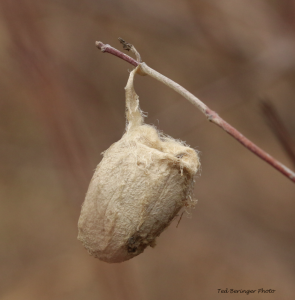Moth Cocoons in the winter
Moth Cocoons in Winter
by Ted Beringer
Now that the leaves have fallen, your unobstructed eyesight may spot tiny wonderful structures constructed by moths or other insects dangling from small branches of trees and shrubs in the park or other relatively wild areas near your home (perhaps even in your own yard). Children get a kick out of discovering them. Cocoons are really hard to identify. Size and shape are your only clues.This one resembles a giant silkworm moth cocoon. It doesn’t have quite the shape of a Cecropia. It could be a Polyphemus, or maybe a Luna.There’s an excellent website dedicated to cocoons with all kinds of information. Check it out at Cocoon.org.

